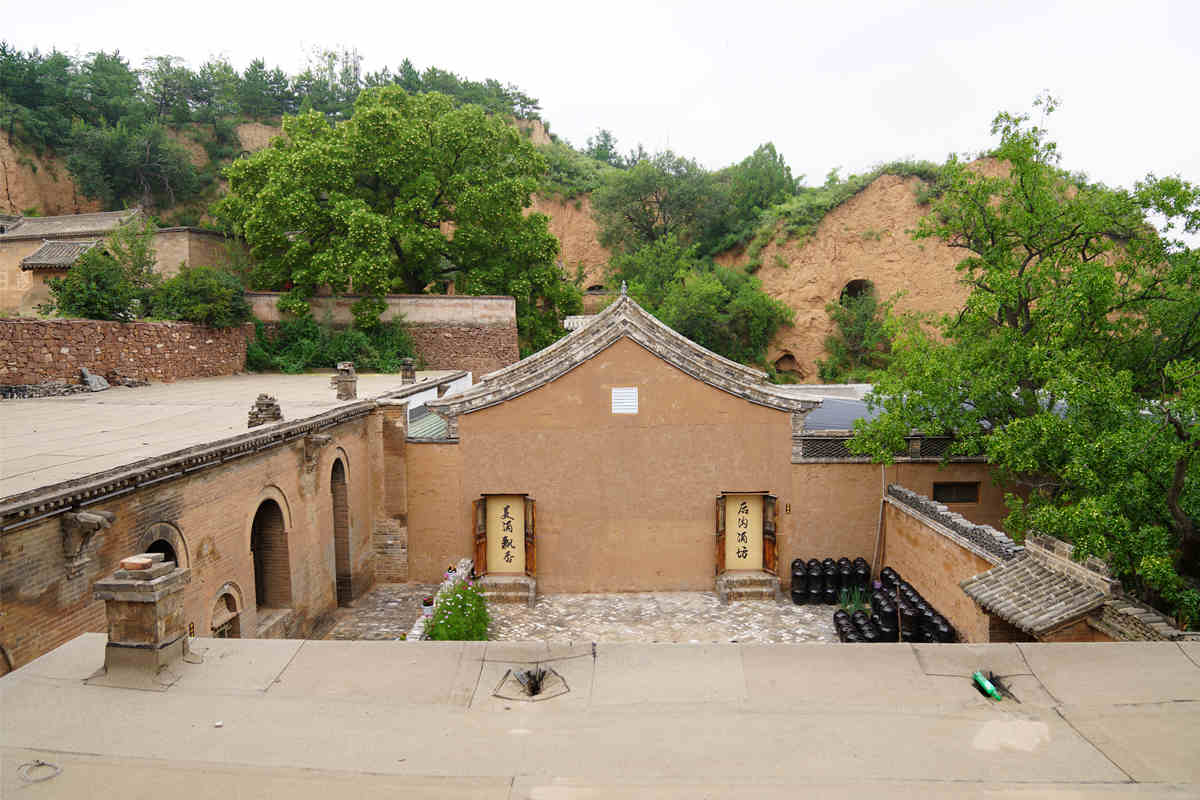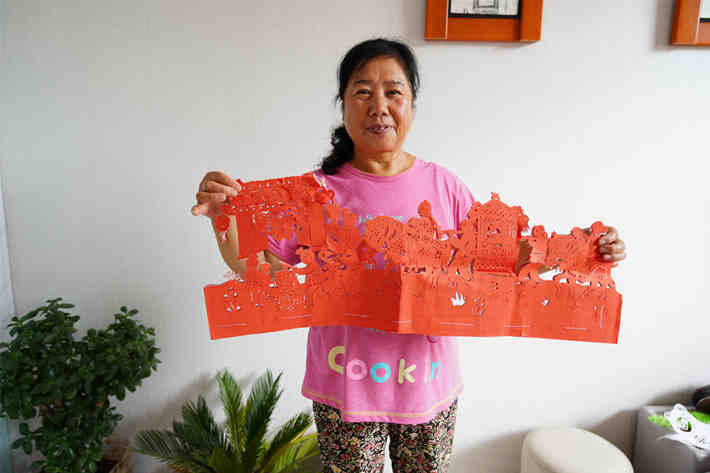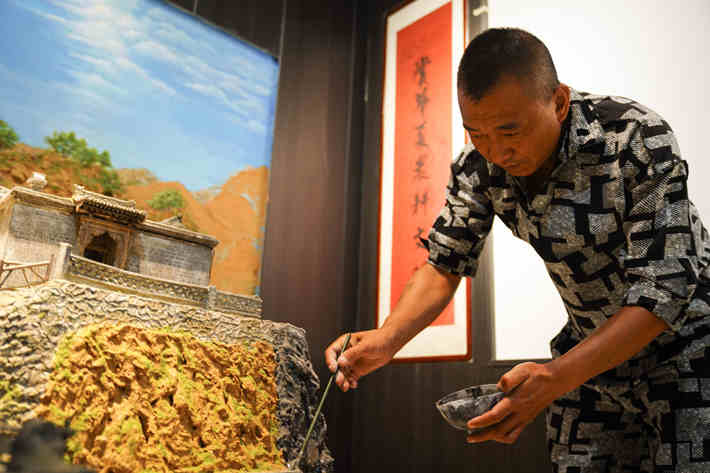New Shine of Old Villages

China is home to numerous time-honored villages of various forms and designs. They are the living cultural legacies, embodying harmonious coexistence between human and nature. The country’s rural revitalization drive is helping the villages embrace new cultures and more civilized living have made local features more prominent.
Not long ago, China Pictorial reporters visited Hougou, Hengpo, and Baiyan, three ancient villages in Jinzhong City, Shanxi Province. Specifically, we wanted to figure out how ancient villages protect their historical and cultural heritage while promoting rural revitalization.

Zhang Jinye and her paper-cut works. (Photos by Guo Xiangmei/China Pictorial)
Cultural Memories of an Ancient Village
Hougou Village, located in eastern Yuci District, Jinzhong City, boasts a history of about 1,000 years. Many ancient structures, including courtyards and cave dwellings, are well preserved there. And many gorgeous time-honored buildings such as an opera stage, the Guanyin Temple, and the Temple of Guan Yu still stand as living fossils of folk culture of northern China.
In November 2002, Feng Jicai, then chairman of the Chinese Folk Literature and Art Association, visited Hougou with some of his colleagues. After field research, they agreed that the village was a treasure trove of spiritual beliefs, classical production methods and living conditions, traditional tools, and folk customs of the Han ethnic group living in northern China. The village is a vivid demonstration of Chinese historical and cultural heritage which is rarely seen nowadays.
As Hougou became increasingly well-known, it began to attract many researchers and tourists alike. For city dwellers, the village offers amazing yet different rural scenery and cultural enjoyment.

Zhang Junwen and his work My Hougou Village made of cornstalks. (Photos by Guo Xiangmei/China Pictorial)
It’s hard to walk through the village of Hougou without seeing so many distinct cave dwellings there. The courtyards were built against cliffs, in accordance with the natural landforms. The local environment is quiet and peaceful. Many traditional agricultural skills and methods on the Loess Plateau are well preserved. Old-fashioned workshops producing wine, tofu, and vinegar still operate as an integral part of the local life.
By harnessing its resources, Hougou Village has developed other industries such as family-run restaurants and hotels. Incomes have increased, and awareness of the need to protect intangible cultural heritage and revive traditional handicrafts is widespread.
The Grape Courtyard, a family-run restaurant and hotel in Hougou Village, is known for its “paintings” made of cornstalks. All the pieces were produced by local villager Zhang Junwen and his wife. “We made many pieces about our village,” Zhang said. “We thought it would be a good way to promote the village while earning some money during the pandemic.”

Wang Xudong, a member of the Jinzhong Municipal Folk Literature and Art Association, with one of his clay models of an ancient structure in Hougou Village. (Photos by Guo Xiangmei/China Pictorial)
To preserve the architectural wisdom of his predecessors, Wang Xudong, a member of the Jinzhong Municipal Folk Literature and Art Association, set up a studio in the village to produce a series of clay-baked models of ancient structures. Villager Zhang Jinye created many paper-cuts inspired by Hougou’s opera stage, seasonal scenery, classical architecture, and traditional folk customs. Besides, she has been endeavoring to pass the art to more young people.
In 2018, Hougou built a whole new village just a kilometer away to better protect the ancient legacy. Almost all villagers moved into new homes. The well-preserved old village forms gorgeous rural scenery alongside the new village which boasts well-grounded infrastructure and an impressive design. It is a perfect combination of history and modernity.
Ecological Protection Boosts Local Development
Hengpo, a traditional Chinese village, is located in Duancun Township, Pingyao County, Jinzhong City. Only a decade ago, the village was plagued by inconvenient transportation, power shortages, and difficult access to safe drinking water. After years of afforestation efforts, Hengpo has transformed from a small mountainous village with poor transportation infrastructure into a national forestation village.
“Our village is only a 30-minute drive from the ancient city of Pingyao, which was listed as a UNESCO World Cultural Heritage site for its sound preservation of the urban landscape,” said Guo Xingfeng, Party chief of Hengpo Village. “Many tourists come to our village to experience rural life after visiting Pingyao, enabling them to soak up the charm of ancient Chinese villages and towns.”
In addition to family-run restaurants and hotels, Hengpo has also developed a number of tourism-plus projects such as cave hotels, an amusement park for kids, a zipline, and a bird zoo. Maximizing opportunities created by major local events such as the Pingyao International Photography Festival, Hengpo organizes activities such as a lantern show during Chinese New Year to promote local tourism. As of 2020, the village had received more than 2 million tourists from around the world and earned revenues exceeding 40 million yuan (about US$5.8 million).

Villagers and tourists watch an opera performance on the ancient stage in Hougou Village. Local artists can still perform repertoire popular in the 1950s if needed. (Photo courtesy of the Party committee of Dongzhao Township)
Baiyan Village, located in Xiaobai Township, Taigu District, Jinzhong City, is another example of rapid rural development. Known for abundant prehistoric artifacts, Baiyan is home to cultural relics from the Yangshao Culture, which is well-known for its red painted pottery during the Neolithic Period to the Eastern Zhou Dynasty (770-256 B.C.). The cultural relics include a considerable volume of pottery as well as production equipment and daily utensils.
Baiyan also focuses on promoting afforestation and returning farmland to forest. The village ultimately became prosperous because of the seedling industry. Its planting area for seedlings has reached 247 hectares, with more than 150 seedling varieties for greening and gardening and many high-quality seedling cultivation and exhibition bases. Now, the village is home to the largest seedling and flower park in Shanxi Province and the largest lacebark pine planting base in northern China.
“The ecological development of the seedling industry brought prosperity to the locals, and it also lays a solid foundation for the village’s long-term development,” said Wang Zhen, secretary of the Party committee of Baiyan Village and director of the village committee. “Per capita income has reached 22,000 yuan (about US$3,200), topping all villages in Taigu District.” Today, Baiyan Village continues to restore traditional ancient courtyards and conduct research on local cultural sites and legacies. In 2020, the village was honored as a National Civilized Village. “Baiyan has potential for even greater prosperity,” added Wang. “I firmly believe that it will soon become an ideal place for eco-cultural tourism.”